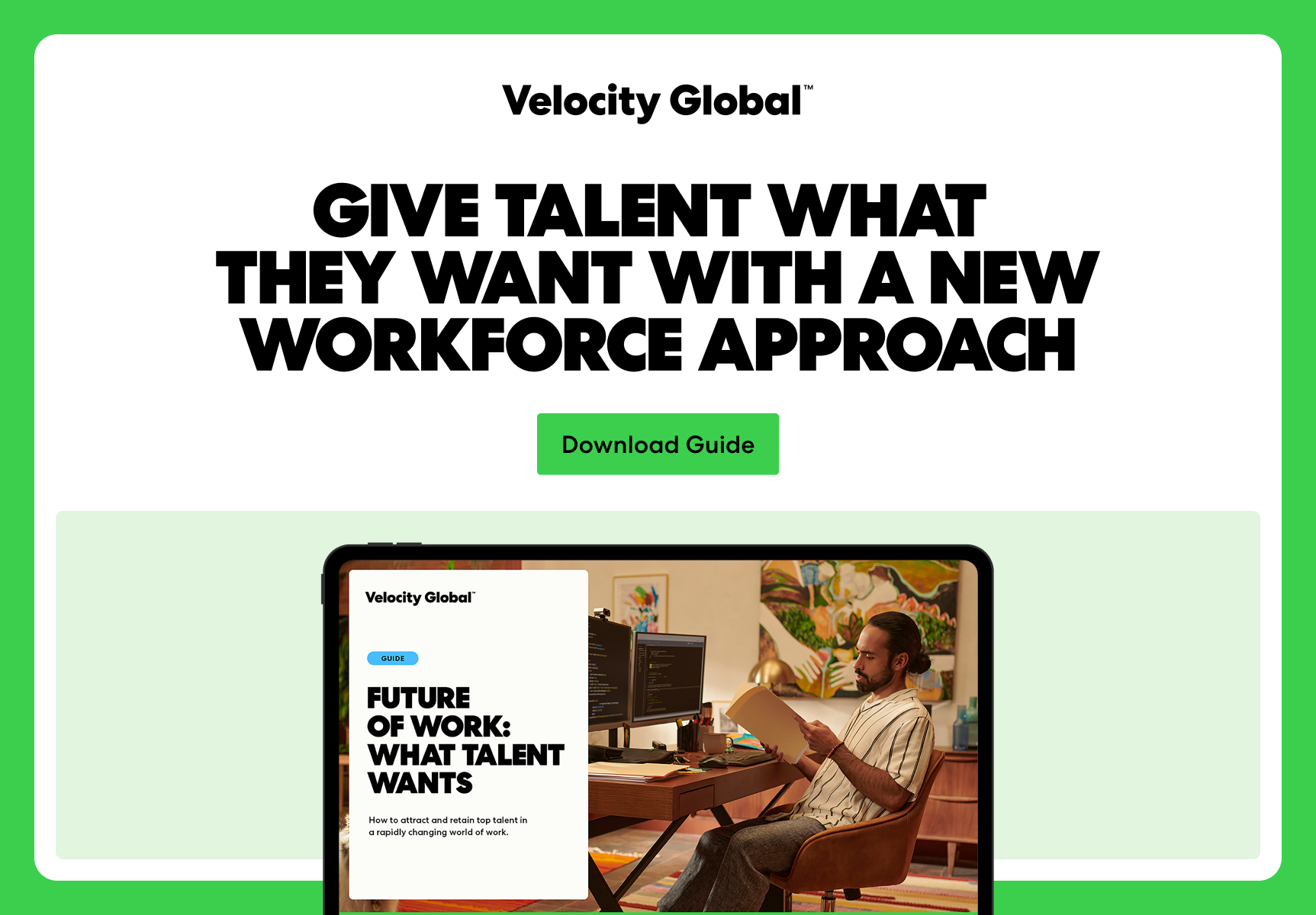When we think about “flexible work,” we typically think of working from home—but there’s more to it than offering remote work or work-from-home options.
Think about where and when you are most productive. Do you do your best work at a busy coffee shop, or in your office next to an open window? Do you need people to engage with in your day-to-day routine, or do you prefer to work independently?
As individuals, we all have different strengths, challenges, and backgrounds—all of which vary from those of other people on our team. These things shape our needs and, consequently, the unique requirements for our ideal work environment.
Addressing those needs and fulfilling those requirements through flexible work models enables your organization to be more innovative and diverse, boosting productivity and helping you retain essential talent.
Understanding Your Team’s Needs
Today’s top talent wants flexible leadership that empowers them to do meaningful work and recognizes their contributions as well as their individual needs. Every team consists of people with varying needs that may require different levels of flexibility to perform certain tasks.
From physical limitations to personal obligations, it’s important to understand and accommodate your team’s individual needs to ensure a productive and inclusive work environment.
Neurodivergence
Not everyone has the same brain. Neurodivergent people—or those whose mental or neurological functions differ from what is considered the baseline for most individuals—may have a variety of needs that others do not.
For example, sensory issues such as difficulty processing sight, sound, touch, or even speech may make work challenging in ways that neurotypical people, or people not characterized as neurodivergent, can’t easily imagine.
Physical
Certain physical differences can prevent employees from working a traditional schedule or in an office. For example, some may have health or medical conditions, mobility impairments, and visual or hearing issues.
Religious
Depending on the religious practices of your talent, they may appreciate the flexibility to schedule prayer times or even prolonged time off for important holidays.
If your company provides food for talent in the office or at events, consider dietary restrictions based on different religions. Having pulled pork sandwiches catered for events may be a crowd-pleaser in some cases, but it won’t benefit those who practice religions that don’t allow for the consumption of meat.
Family
Some individuals in your workforce may require flexibility because of familial obligations. Many parents need to pick up their kids from school and need to leave the office before everyone else.
Others may have elderly or sick family members to care for. This could look like ongoing appointments during the day, which may not always match the traditional nine-to-five office schedule, or last-minute trips to be closer to sick relatives.
By only offering one way of work, you exclude groups of people from contributing their valuable talent to your company.
Sleeping
Not everyone functions optimally at the same time of day. Some people are night owls who thrive late at night or during the earliest hours of the morning. Others prefer to wake up with the sun, starting their day before most people get out of bed.
Offering flexible work schedules tailored to how your talent’s bodies optimally function. This includes the option to work asynchronously, which allows you to capitalize on their contributions at maximum efficiency and empower them to live the lifestyle they want.
How to Promote Flexibility in the Workplace
Flexible leadership means knowing how to set your workforce up for success with working conditions that cater to the various needs of your team.
Offering flexible schedules and workplace modifications are just a couple of ways to give talent a job they’ll never want to give up—and one that plays to their strengths as a professional.
Flexibility in Location
The benefits of remote work are now a well-trodden subject. We know that today’s top talent wants the option to work from anywhere and employers who offer a flexible work model enjoy many benefits, like improved retention and productivity.
Less than 10% of employees say they prefer to work on-site. Despite this, several employers are still calling for a return to the office.
Forcing your talent to work on your terms instead of theirs not only undermines their trust in you but also excludes those with certain requirements that are not conducive to the traditional in-office work model.
Offering your talent the freedom to work from anywhere makes your organization more attractive to top talent and more inclusive to a broad range of people with different needs.
Ninety-five percent of tech leaders say that adopting a distributed workforce model benefitted their company in one way or another. Start a conversation with your talent—ask themyour team when they are at their most productive and what their ideal work week looks like, then make a plan to establish transparent expectations and boundaries that allow them to work a schedule that they’ll love.
Flexible Work Schedules
Even employers who offer the option of a hybrid or work-from-home schedule sometimes include a caveat: they require everyone to work at the same time.
Allowing your talent to work asynchronously with flexible schedules enables them to get their work done at the time that best suits them. This gives your employees the freedom to schedule their workday around school drop-offs or dentist appointments, stretch their legs when they need to, or even manage symptoms of an illness. Furthermore, adopting practices like sharing instructions through recordings or visual guides sets your organization up for global hiring by allowing your teams to operate smoothly across multiple time zones.
Even the controversial four-day workweek has proven beneficial, according to various sources. In February 2023, the nonprofit 4 Day Week Global published their results of a pilot study involving 47 companies in the U.K. The companies that took part in the study reported that employees experienced lower levels of stress, anxiety, burnout, fatigue, and sleep issues, as well as improved work-life balance, with no change in revenue. In 2019, Microsoft Japan also experimented with a four-day work week. Besides lower levels of stress and burnout, the company reported a 40% increase in productivity and no loss of revenue.
Alternative Work Arrangements
We know not everyone can do the same job the same way. Workplace modifications and accommodations allow everyone to contribute from a similar baseline.
Working with your talent collaboratively and positively is important to find solutions for any potential issues. For example, investing in speech-to-text tools can help people with hearing or speech-processing issues adapt to their job more effectively.
Managing your team based on their learning and communication styles can produce the same results. If an employee is more of a visual learner, for example, they might benefit from detailed instructions with screenshots that describe how to perform a specific task more than they would from audio instructions.
Benefits
Providing a flexible employee benefits plan is another excellent way to promote workplace flexibility (as well as improving the productivity of your talent). Offering a choice of benefits your talent can tailor to their individual health needs gives them access to:
- Specialized services to support alternative work arrangements
- Equipment for workplace modifications
- Prescription medication to manage chronic health conditions
- Anything else they need to stay healthy
It also improves retention—a 2023 Metlife study found that employees who are satisfied with their benefits are more likely to be loyal to their current employer.
Flexibility in Growth
Fostering the professional growth of your employees is crucial for retention, but not everyone wants to be a manager. Putting all your top-performing employees on a management track doesn’t just set them on a path that may not be right for them; it also cheats your teams out of the unique contributions they can make.
Talk to your talent about their career goals. Is there a specific skill they want to learn or a different role they’d like to pursue within your company outside the traditional promotion cycle?
By fostering the professional development of your team, you may find the talent you already have may be suitable for internal roles you need to fill or projects for which you would otherwise need to hire new talent.
The Future of Work Is Flexible
The future of work is here—and it’s built on flexibility.
We’re helping organizations like yours build teams that will drive innovation by future-proofing your workforce and hiring models, making it easy to provide flexible leadership and work conditions.
Contact us today to find out more about how Velocity Global can help.
We know what talent wants—and how to give it to them.
Want to learn more about the future of work? Download our guide today.




